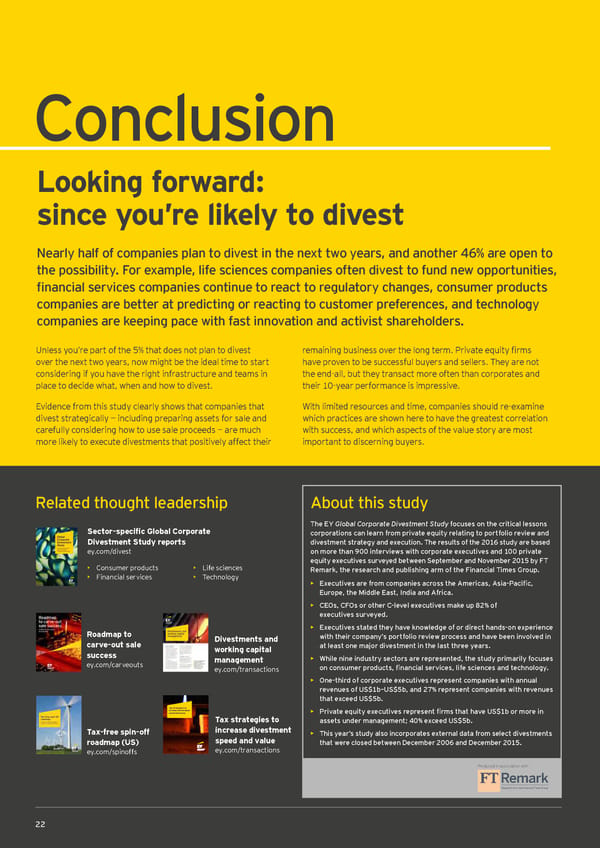Conclusion Looking forward: since you’re likely to divest Nearly half of companies plan to divest in the next two years, and another 46% are open to the possibility. For example, life sciences companies often divest to fund new opportunities, financial services companies continue to react to regulatory changes, consumer products companies are better at predicting or reacting to customer preferences, and technology companies are keeping pace with fast innovation and activist shareholders. Unless you’re part of the 5% that does not plan to divest remaining business over the long term. Private equity firms over the next two years, now might be the ideal time to start have proven to be successful buyers and sellers. They are not considering if you have the right infrastructure and teams in the end-all, but they transact more often than corporates and place to decide what, when and how to divest. their 10-year performance is impressive. Evidence from this study clearly shows that companies that With limited resources and time, companies should re-examine divest strategically — including preparing assets for sale and which practices are shown here to have the greatest correlation carefully considering how to use sale proceeds — are much with success, and which aspects of the value story are most more likely to execute divestments that positively affect their important to discerning buyers. Conclusion Related thought leadership About this study In light of rapid technological advances, regulatory changes, increased shareholder scrutiny and customer purchasing power and demand shifts, strategic portfolio reviews are the most important tool to optimize capital allocation. Decisions regarding which assets to invest in or sell off will drive a company’s competitive advantage and long-term growth. Frequent and effective reviews help companies avoid some symptoms of portfolio inertia that negatively impact The EY Global Corporate Divestment Study focuses on the critical lessons Sector-specific Global Corporate business performance: corporations can learn from private equity relating to portfolio review and Lack of alignment between capital allocation and the strategic value of portfolio components Divestment Study reports • divestment strategy and execution. The results of the 2016 study are based Neglecting market trends, resulting in investment gaps and missed opportunities ey.com/divest • on more than 900 interviews with corporate executives and 100 private Reactive postures that result in lower-quality investment options and wasted effort in evaluating • equity executives surveyed between September and November 2015 by FT • Consumer products • Life sciences non-strategic options Remark, the research and publishing arm of the Financial Times Group. • Financial services • Technology An effective portfolio review agenda is based on an up-to-date de nition of the core business — that is, a clear model of where the company should be focusing its capital to reach current and future market needs. The review itself should then • Executives are from companies across the Americas, Asia-Pacific, Europe, the Middle East, India and Africa. analyze whether each business unit ts within that core strategy. Performing this assessment regularly — ideally, every six months — should reveal divestment candidates as those business units that are under-performing or non-core to strategic goals, as well as those that may have greater value for another • CEOs, CFOs or other C-level executives make up 82% of executives surveyed. owner or as a separate entity. But portfolio review results are only effective if companies dedicate resources to implement suggested changes and divest units that are a poor strategic t. Companies are realizing that divestments are a growth tool, similar to acquisitions. Those that adopt leading practices are • Executives stated they have knowledge of or direct hands-on experience Roadmap to completing divestments that achieve higher sale prices and are rewarded by investors through stronger valuation with their company’s portfolio review process and have been involved in Divestments and multiples on the remaining business. These high performers, just 12% of executives, are in a better position to adjust to carve-out sale changes within their sector and in the economy as a whole. working capital at least one major divestment in the last three years. success management • While nine industry sectors are represented, the study primarily focuses ey.com/carveouts ey.com/transactions on consumer products, financial services, life sciences and technology. • One-third of corporate executives represent companies with annual Respondent demographic revenues of US$1b–US$5b, and 27% represent companies with revenues that exceed US$5b. 80% of executives are CEOs, CFOs or other C-level executives. • Tax strategies to increase divestment Executives are from companies across the Americas, Asia-Paci c and Europe, the Middle East, India speed and value • • Private equity executives represent firms that have US$1b or more in Tax strategies to assets under management; 40% exceed US$5b. and Africa. More than eight industry sectors are represented. Tax-free spin-off increase divestment • • This year’s study also incorporates external data from select divestments More than half of the executives represent companies with annual revenues that exceed US$1b. speed and value • roadmap (US) that were closed between December 2006 and December 2015. Executives stated they have knowledge of or direct hands-on experience of their company’s portfolio review ey.com/transactions • ey.com/spinoffs process and divestment activity. Produced in association with Remark Research from the Financial Times Group 22 32
 Global Corporate Divestment Study Page 21 Page 23
Global Corporate Divestment Study Page 21 Page 23